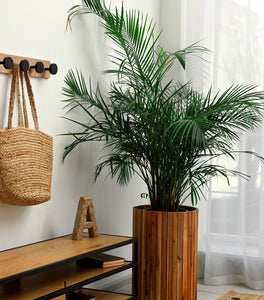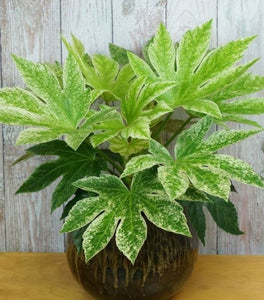
Images Depicted Range in Maturity & Container Size
Pots & Decorations Not Included Unless Otherwise Stated
Bold, Sculptural Color for Bright Indoor Spaces
A Houseplant That Brings the Drama
Croton Mammy is one of the most striking indoor plants you can grow, featuring twisted, ribbon-like leaves that curl, arch, and spiral in every direction. Each leaf is splashed with saturated tones of red, orange, yellow, and deep emerald, creating a vivid, painterly effect that changes depending on where the plant is situated in your home. No two Croton Mammy plants are alike, which makes each one feel like a living piece of art. It’s the perfect statement plant for those who love bold color and expressive texture.
Its dramatic foliage is even more striking when placed where light filters through the leaves — the colors glow like stained glass. Unlike many colorful foliage plants that require special conditions, Croton Mammy adapts surprisingly well to indoor environments when provided with bright light. This makes it an excellent choice for living rooms, home offices, sunrooms, and anywhere you want a plant with strong personality and sculptural presence.
Glossy Foliage and Compact Form
Croton Mammy grows upright to a manageable 2–3 feet tall indoors, making it easy to style on tabletops, plant stands, shelves, and decorative containers. The foliage forms a dense, bushy structure that feels full and polished — even when young. Over time, it develops a branched, tree-like form that further enhances its visual presence. This natural growth habit allows it to serve as either a stand-alone focal point or as part of a curated plant grouping with palms, ferns, and trailing foliage plants.
What sets Croton Mammy apart is the curling leaf shape — a trait not found in most Croton varieties. This flowing, sculptural form gives the plant a sense of movement and energy. Whether your interior style is modern, bohemian, tropical, maximalist, or eclectic, this plant adds depth, contrast, and visual interest without overwhelming the space.
Thrives in Bright Light
Color intensity is tied to sunlight — the brighter the light, the richer the color. Croton Mammy flourishes near east-facing windows, sunrooms, glass doors, and other bright exposures. If placed in a slightly lower light setting, the foliage will remain attractive, but the colors will soften to greener tones. This makes the plant highly adaptable: it can thrive in high-light showcase positions or settle comfortably into everyday household environments.
Once established, Croton Mammy is surprisingly low-maintenance. It prefers a regular watering rhythm, steady temperatures, and moderate humidity. Providing a pebble tray, light misting, or pairing it with other humidity-loving plants helps maintain leaf vibrancy. With a consistent care routine, this plant rewards you with ongoing new leaves and evolving patterns of color.
A Decorative Accent Plant With Style
Croton Mammy is a designer favorite because it instantly elevates any interior composition. Its vivid color palette complements warm wood tones, neutral décor, houseplants with broad green leaves, and bright contemporary spaces. Use it to anchor corners, enhance side tables, frame windows, or brighten hallways and entryways. It also performs beautifully in container groupings, adding height variation and visual rhythm.
When grown outside in warm climates or used as a seasonal patio plant, its colors intensify even further. Pair it in outdoor containers with deep green ferns, tropical palms, or chartreuse sweet potato vine for a lush, layered display. Whether indoors or out, Croton Mammy’s year-round color ensures that your space always feels alive, warm, and welcoming.

| Hardiness Zone: | 10-12 Outdoors |
|---|---|
| Mature Height: | 2 to 3 Feet |
| Mature Width: | 1 to 2 Feet |
| Classification: | Colorful foliage |
| Sunlight: | Bright, direct light to full sun |
| Habit: | Compact habit |
| Foliage: | Spotted red, yellow, green and orange |
| Soil Condition: | Potting mix with sand and perlite added |
| Water Requirements: | Likes to be consistently moist but not waterlogged |
| Uses: | Attractive plant to add bold color indoors |
How to Care for Codiaeum variegatum ‘Mammy’ (Croton Mammy)
Be sure to read our planting instructions to ensure a healthy and happy Croton Mammy plant for years to come!

How should I plant Croton Mammy?
Choose a container with drainage holes to prevent water from pooling at the bottom, which can lead to root rot. Fill the bottom of the pot with a well-draining indoor potting mix, preferably one with perlite or coconut coir for aeration. Gently remove the plant from its nursery pot and loosen the outer roots before setting it so the top of the root ball sits even with the surrounding soil. Backfill lightly, press to remove air pockets, and water slowly until the soil is evenly moist. After planting, place Croton Mammy in a location with bright, indirect light — think near east- or south-facing windows, but shielded from hot afternoon sun. Avoid cold drafts, air vents, or areas where temperatures fluctuate dramatically. If the plant is transitioning from one lighting environment to another, move it gradually to avoid leaf drop as it adjusts.
How often should I water Croton Mammy after planting?
Allow the top 1–2 inches of soil to dry between waterings, then water thoroughly, allowing excess moisture to drain freely. Crotons prefer consistent moisture but do not tolerate soggy soil, so always empty saucers after watering. Use room-temperature water to prevent shock to the roots, and avoid long periods of dryness, which can lead to leaf curl or drop. Humidity is especially beneficial for Croton Mammy — aim for moderate indoor humidity (40–60%). If your home is dry, especially during winter heating months, mist occasionally, use a pebble tray under the pot, or place the plant near other leafy houseplants to create a naturally humid microclimate. Consistency is key: stable humidity and watering rhythm = stable foliage.
When should I fertilize Croton Mammy?
Feed monthly during spring and summer when the plant is actively growing. Use a balanced, diluted liquid houseplant fertilizer, feeding at half strength to avoid salt buildup in the soil. Fertilization during the growing season helps maintain strong new growth and keeps foliage color vibrant and saturated. During fall and winter, reduce feeding to every other month or pause fertilization entirely, as growth naturally slows. If leaf color begins to fade, reassess light levels before increasing fertilizer — Crotons respond to light first, nutrients second. A flush of new color usually follows once the right lighting balance is restored.

When and how should I prune Croton Mammy?
Prune only to shape, control height, or remove yellow, damaged, or old leaves. Use clean, sharp shears to cut leaves or stems at their base where they meet the main stem. This plant branches well after trimming, so removing a top stem can encourage bushier, fuller growth. It’s best to prune in late spring or early summer when the plant is actively producing new foliage. Avoid heavy pruning during winter dormancy. Regular light grooming — removing dust from leaves, turning the plant weekly for even light, and trimming occasional spent leaves — will keep Croton Mammy looking polished and vibrant.















